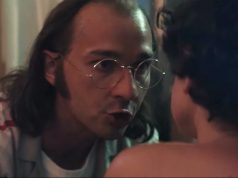Fans of atmospheric, Gothic horror were jubilant when “Let the Right One In” arrived from Sweden two years ago, a balm to soothe the pain left by so many lackluster monsters and sparkling teenage vampires. Many hearts sank when it was announced that an unnecessary American remake, retitled “Let Me In,” would be produced, but be of good cheer: As unnecessary American remakes go, “Let Me In” is outstanding. Whatever its genre is — horror? drama? coming-of-age story? — it’s one of the best of 2010.
Matt Reeves (“Cloverfield”) wrote and directed this adaptation, using the Swedish novel and its film (both written by John Ajvide Lindqvist) as source material. It’s been two years since I saw “Let the Right One In,” but I suspect a person who watched it and “Let Me In” back to back would find the remake very similar without being a photocopy. Reeves — unknown as a filmmaker apart from “Cloverfield” — must have remarkable range; “Let Me In” and “Cloverfield,” while both dealing with fantastical creatures, couldn’t be more different in terms of tone, style, and content. You’d never guess the same guy directed both of them.
“Let Me In” is set in 1983 in Los Alamos, N.M., where the winter weather is snowy and forlorn, the way I assume it is in Sweden year-round. Owen, a skinny 12-year-old played by Kodi Smit-McPhee (“The Road”), lives in an apartment building with his divorced mother (Cara Buono), who is so absent from his life that we never see her face clearly. Owen is bullied at school, lonely at home, left to fantasize about getting revenge on the mean kids and to spy on the neighbors.
Into the apartment next door moves a girl about Owen’s age, Abby (Chloe Grace Moretz, from “Kick-Ass”). She lives with a man one assumes is her father (Richard Jenkins), and she is always barefoot. Abby takes a liking to Owen, but she is cautious about becoming his friend, on account of she’s a vampire. You know how it is.
Their friendship develops anyway, two lost souls finding kinship. Owen is kept in the dark about Abby’s dietary habits, but Reeves shows them to us in stark, emotionless detail. (The carnage catches the attention of a police detective played by Elias Koteas.) The matter-of-factness of the vampire incidents, a tactic borrowed from “Let the Right One In” director Tomas Alfredson, increases their horror. Reeves’ attention to bloody realism may shock us at times, but he never seems to be trying to shock us. The violence somehow comes across as both graphic and understated, as if Reeves feels it’s vital to the story but doesn’t want to dwell on it.
But the horror elements, while effective and unsettling, aren’t the film’s central purpose, and the story has some clunky plotting near the end anyway. What’s liable to stick with you most are the somber, heartrending performances by Smit-McPhee and Moretz, two soulful young actors who perfectly convey the mournfulness of pre-adolescence. (Michael Giacchino’s haunting, elegiac score adds immeasurably to the film’s impact.) The plight of a teenage vampire is a sad one, but think also of the poor boy who grows attached to her. Owen is accustomed to seeing meanness that he’s too young to comprehend — his estranged parents’ disdain for one another, the behavior of the school bullies — and when he sees Abby’s monstrous desires in action he figures it’s just one more thing about this cruel world that he doesn’t understand. It’s heartbreaking. Rarely has a vampire story’s “loss of innocence” theme felt so profound.
A- (1 hr., 55 min.; )





